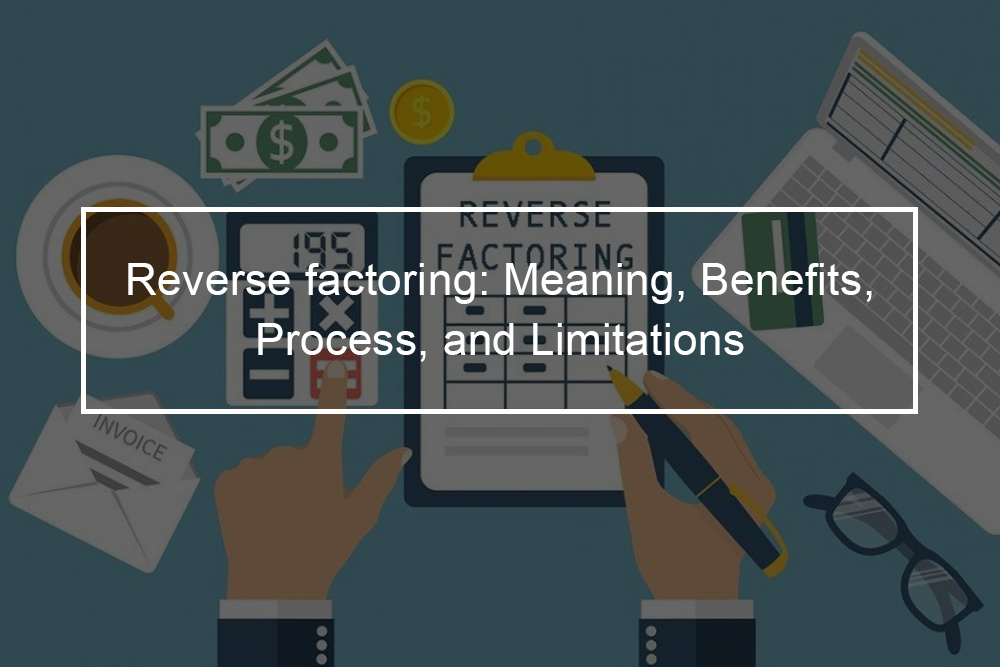Reverse factoring might sound like (invoice) factoring; however, the two are very different. Reverse factoring works by funding invoices for suppliers. This is downstream financing instead of upstream (financing customer invoices), as is done in invoice factoring. For this reason, reverse factoring is also known as supply chain factoring.
The definition of reverse factoring
Typically, reverse factoring is a traditional approach to modern-day supply chain finance. It is a buyer-led funding option wherein both the buyers and suppliers obtain a short-term credit against the invoice. With reverse factoring, the suppliers sell invoices to financial institutions or banks at a pre-determined discount rate. The supplier receives immediate access to cash by selling invoices while buyers get more time to pay the invoices. Think of reverse factoring as a three-way financing process wherein financial institutions, buyers, and suppliers all three are involved in the transaction. Generally, reverse factoring provides liquidity to business and helps in optimizing working capital for both the parties. The benefit here is that the discount rate at which the financial institution or bank settles the invoice is lower than the buyer’s own operating funds sources. Thus, we can say that reverse factoring is a cheaper short-term finance option for buyers.
How reverse factoring works?
Reverse factoring, so-called supply chain finance, works differently, in the opposite direction of invoice factoring. Rather than a business factoring customer invoices, it factors supplier invoices. In doing so, the business is factoring a section of the supply chain. Generally, reverse factoring is an account payable solution. To have a better understanding of how the reverse factoring process works, let us look at the workflow steps. Below the buyer is the business that initiates reverse factoring. Typically, they are the buyer of supplier products. Usually, this is the manufacturer but not all the time.
- The buyer is attempting to extend terms with suppliers so that the suppliers will be paid later. Extending terms is not something suppliers have a motive to do.
- The buyer finds a financing company or a bank for the supplier invoices.
- The financing company offers to finance the receivables of some suppliers.
- The suppliers accept to fund.
- Suppliers deliver services or goods and invoice the buyer (the debtor).
- Supplier invoices are sent to the bank.
- The buyer accepts invoices to be funded.
- After some later time, the buyer pays the invoices. The payment is sent to the bank.
Let us look a little deeper at the process. In step three, suppliers accept financing since they are getting paid in ten days rather than sixty, for example. Indeed, a fifty days advance for a small charge is worth the price. But one question to ask is: Why would a supplier accept financing? It is the buyer who started reverse factoring after all. The supplier does not need financing. However, if the supplier disagrees, then the buyer will be out of luck for the most part. Typically, the main reason the supplier accepts financing is that they get paid much sooner. But, for this early payment, there is a small fee involved. When it comes to the buyer, their fee comes in the form of an interest rate.
Note that reverse factoring does not always mean that the manufacturer is the one in need of working capital or cash. The supplier might be the one in a cash flow crunch and in need of a cash injection. And is that not the supplier’s problem? Yes, however, it also impacts everyone further up in the supply chain. If the supplier’s issue is not solved, everyone suffers. It is worth it to the manufacturer to resolve the supplier’s problem and get the supply chain moving again.
What Are The Requirements Of Reverse Factoring?
Companies that are looking for reverse factoring are generally seen on a case by case basis. Usually, a financier would ask for the following in an application:
- information on liabilities and assets
- Details and references of the directors
- Credit reports
- Financial forecasts
- Full business plans
- Audited financial statements
Why is reverse factoring important?
Typically, suppliers have a challenging relationship with many corporates since these buyers dictate their payment terms. Moreover, suppliers do not want to wait a long time to be financed since they are usually fueling businesses with high capital expenditure costs. Besides, suppliers understand the huge chance they are presented with when faced with a purchase contract from one large entity. Generally, reverse factoring began in the car industry, since it enabled car companies to work more efficiently with their smaller supply companies. It also helps in industries where payment delays are the main challenge or hindrance to business.
What Are The Benefits Of Reverse Factoring?
Benefits of reverse factoring for both suppliers and buyers
Reverse factoring benefits to the buyers
- Since this is an off-balance sheet finance option, the buyer’s overall balance sheet also looks good with better ratios of trade payables turnover, working capital turnover, days payables outstanding, etc. This helps in raising other sources of finance at better rates.
- The buyers can benefit from cash discounts while still paying for the invoice’s invoice maturity date.
- The buyer can have longer payment terms with the suppliers without negotiating any other factor, like prices.
- The trade payables increase so the buyer experiences efficiency in daily operations. This further results in working capital optimization for the buyer.
Benefits of reverse factoring to the suppliers
- The suppliers get faster access to cash at advantageous rates. Typically, they stop waiting on large clients to pay overdue invoices. Rather, they receive early payment for invoices to continue operations. This will also result in a faster cash conversion cycle from delivery to cash.
- Like the buyer’s advantage, the suppliers’ overall balance sheet also appears good and can get future finance at better rates.
- Sub-investment and non-rated grade suppliers gain access to cheaper capital. The interest rate charged by a funder depends on the buyer’s credit and not that of the supplier.
- Reverse factoring offers greater payment predictability. All approved invoices are uploaded and accessible for early payment.
- Diversify your sources of cash. Reverse factoring offers an inexpensive, off-balance-sheet way to maintain operations and boost growth.
Benefits of reverse factoring to both suppliers and buyers
- There are some combined benefits to buyer and supplier: Both the supplier and buyer experience smoother procedures as they have to deal with banks or financial institutions for payments. This further translates to the strong cooperation between suppliers and buyers, which creates a competitive advantage.
What Are The Limitations Of Reverse Factoring?
Distrust between buyer and supplier – If there is a lack of trust between the buyer and supplier, they will not utilize reverse factoring. Reverse factoring is a combined financing solution where both buyer and supplier commits fulfilling the bank or financial institution’s terms. For instance, if the supplier sells the invoice and the buyer does not pay, then the supplier will be responsible. This clearly will not work.
Reverse factoring – as a business solution
Typically, technology has had an important role to play in the rise of reverse factoring. In the early 1990s, reverse factoring was not only offered to large corporate buyers but also only a handful of banks provided this. With the growth in technology, there was a rise in financial technology firms as well. Both financial technology and banks started providing reverse factoring as a means of finance and as a business solution.
The finance providers began making online platforms to automate the reverse factoring process and offer more efficient business solutions. These platforms made the whole procedure more transparent, where multi-party transactions were visible to all the engaged parties. The procedure is designed so that each department, be it legal, IT, treasury, or procurement, is in sync with the transaction. This inclusiveness, simplicity, automation, simplicity, and transparency provided perfect business solutions to sellers & buyers. Now all the major banks and financial institutions offer reverse factoring, and it is offered not only to large buyers but also to SME buyers. Following McKinsey’s report, reverse factoring or supply chain finance has accelerated by 20-percent per annum from 2010 to 2014. This growth is expected to rise in the future. Generally, reverse factoring has evolved through the years, and service providers are now looking towards blockchain technology to enhance the service further.
Reverse factoring versus dynamic discounting
Reverse factoring should not be confused with dynamic discounting, even though there are similarities between the two types of financing. Whereas dynamic discounting is also a solution that allows buyers to offer early payments to their suppliers, there is a key difference: the option is financed not by an external finance provider, but by the buyer. Conversely, when using dynamic discounting, the buyer provides suppliers with an early payment on their invoices in exchange for a discount. In this situation, the buyer can deploy its own cash to achieve attractive risk-free returns, whereas supporting suppliers and lowering the risk of supply chain disruption.












